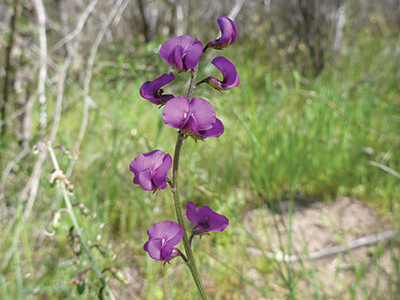The small purple pea (Swainsona recta), an endangered native herb, is being re-established in the wild. The ACT Government is translocating the plant from the Australian National Botanic Gardens into sites around Canberra, to help conserve and restore the delicate ecosystems of the Territory.
“The small purple pea is nationally and locally listed as an endangered species, but its role in our local environment is important to maintain our unique biodiversity,” environment minister Rebecca Vassarotti said.
“These plants grow in grassy woodlands throughout the ACT, NSW, and Victoria, but they’ve been on the decline in recent years.”
The small purple pea was declared an endangered species in the ACT in April 1996, and has special protection status. It is also listed as endangered in NSW and threatened in Victoria. Its population is now fragmented into two clusters, one in central eastern NSW (between Wellington and Mudgee) and the other in the Canberra–Williamsdale district.
While once widespread, its range has declined over the past 80 years, due to urban development, agriculture, inbreeding, reduced genetic diversity, invasive plants, inappropriate fire régimes, and browsing by native and feral herbivores.
In the ACT, the plant grows at Mt Taylor, Kambah, and south-east Belconnen. Although the Mt Taylor population is stable, other populations are small, severely fragmented, and vulnerable to extinction.
“The ACT Government will be carrying out plantings at multiple sites across Canberra to boost some existing populations, and help foster their growth in different areas to support the species surviving and thriving on their own into the future,” Ms Vassarotti said.
“We’ve already seen some success with the species, and prospects look good for populations to be successfully rewilded into our reserves.”
In 2012 and 2013, 112 plants raised at the Australian National Botanic Gardens were translocated to three plots near the Gigerline Nature Reserve in the south of the ACT. Around a third of them survived.
“We’re excited about this collaboration with the ACT Government, which supports our broader mission to help conserve our native flora for future generations,” Zoe Knapp, Australian National Botanic Gardens, said.
“The Gardens maintain the world’s largest collection of Australian native plants, and is a recognised centre of excellence in native plant horticulture, seed science, taxonomy, and education.”
“As September is Biodiversity Month, it’s a poignant reminder that the biodiversity we love in our hometown isn’t just the animals that live here; it’s the plants and grass that they live and feed on, as well,” Ms Vassarotti said. “As we approach the warmer months and head into Spring, I encourage you all to head out to a reserve and see what’s blooming.”



